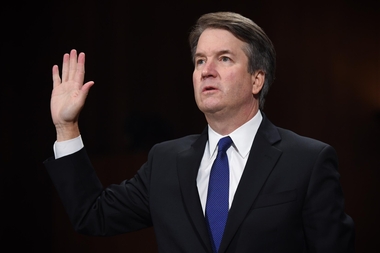For Supreme Court, Kavanaugh marks partisan turning point

Judge Brett Kavanaugh delivered the angriest partisan message heard from a Supreme Court nominee in modern times.
Referring to sexual assault claims made against him by Christine Blasey Ford, he asserted his innocence and then attacked Democrats.
"This whole two-week effort has been a calculated and orchestrated political hit, fueled with apparent pent-up anger about President Trump and the 2016 election, fear that has been unfairly stoked about my judicial record, revenge on behalf of the Clintons and millions of dollars in money from outside left-wing opposition groups," Kavanaugh said.
The judge who previously served as a top aide to President George W. Bush and worked for independent counsel Ken Starr's investigation of President Bill Clinton tossed aside his earlier judicious language of neutrality.
His declaration was the product of his personal anger, to be sure, and the move of a nominee whose professional and personal fate was on the line.
But the result -- of his rhetoric and the overall tenor of the nomination -- means he could forever be marked as a politician on the bench rather than a neutral jurist.
His language provided a striking departure from the usual "judges as umpires" that Kavanaugh, and Chief Justice John Roberts in 2005, had invoked.
Justice Neil Gorsuch, during his 2017 confirmation hearing, contended that, "There is no such thing as a Republican judge or a Democratic judge. We just have judges in this country."
Kavanaugh's approach may also have validated Roberts' oft-expressed fear that the public will believe any nominee who emerges from a politically charged confirmation process would necessarily be a political justice.
Roberts and other justices regularly complain about commentary that casts them as political operators.
It is hard to avoid such conclusions when the justices often split 5-4, the five Republican appointees against the four Democratic appointees.
Just last term, the conservative majority issued a string of narrow rulings that reinforced political perceptions, siding often with the Trump administration and culminating the annual session with a decision that undercut the power of labor unions and reversed a four-decade old Supreme Court precedent.
Before the justices had left the bench that June 27 morning, Trump had tweeted, "Big loss for the coffers of the Democrats."
The case of Bush v. Gore, arising from the 2000 disputed Florida election counts, likely is the most deeply etched political case in the national memory.
The court favored Republican George W. Bush over Democrat Al Gore, along 5-4 ideological lines.
The country has seen other politically incendiary Supreme Court fights in recent decades, notably Judge Robert Bork's defeat in 1987 and Justice Clarence Thomas' narrow confirmation in 1991.
But neither of those came down to strictly partisan votes, with all Democrats on one side and all Republicans on the other.
This time, a purely partisan split is a real possibility, in the 51-49 Republican-controlled Senate.
(Gorsuch, Trump's first nominee, won confirmation with all Republican and three Democratic senators in 2017, although Republicans did away with the 60-vote threshold that ended the ability of Democrats to filibuster the nomination.)
Justice Ruth Bader Ginsburg, who in 1993 was confirmed by a 96-3 vote, often laments the faded bipartisanship.
"The way it was, was right," she said earlier this month. "The way it is, is wrong. I wish I could wave a magic wand and have it go back the way it was."
If Kavanaugh, who has been a judge for 12 years on a prominent Washington-based US appeals court, is confirmed for elevation, he may take steps to try to heal the divide.
Or he may be scarred by the allegations that he said have ruined his life. (He said he believed that Democrats were "lying in wait" with Ford's claim that he attacked her when they were teens until it was nearly time for his confirmation vote.)
In January 2006, Justice Samuel Alito, a George W. Bush nominee facing a Republican-controlled Senate was confirmed 58-42 along largely, but not completely, partisan lines.
Yet he found the process so unsettling that he later complained he disliked walking in front of the Senate Hart Office Building where his hearings were held. He said he crossed to the other side of the street.
Kavanaugh, for his part, warned the Senate Judiciary Committee on Thursday, that the political atmosphere is always changing.
"As we all know, in United States political system of the early 2000s, what goes around comes around."
By Joan Biskupic, CNN legal analyst & Supreme Court biographer. The-CNN-Wire™ & © 2018 Cable News Network, Inc., a Time Warner Company. All rights reserved.
The Gayly. 9/29/2018 @ 12:31 p.m. CST.





